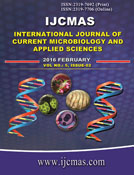


 National Academy of Agricultural Sciences (NAAS)
National Academy of Agricultural Sciences (NAAS)

|
PRINT ISSN : 2319-7692
Online ISSN : 2319-7706 Issues : 12 per year Publisher : Excellent Publishers Email : editorijcmas@gmail.com / submit@ijcmas.com Editor-in-chief: Dr.M.Prakash Index Copernicus ICV 2018: 95.39 NAAS RATING 2020: 5.38 |
Borassus aethiopum is a tropical plant with multiple uses and the hypocotyls are very appreciated by the populations in food and in traditional medicinal. In addition all parts of this tree such as the wood or the stem, the roots, the petioles, the hypocotyls, the leaves, the final bud, the resin, the fruits, the seeds and the sap constitute richness for a rural population. Ethnobotanical survey revealed aphrodisiac properties of hypocotyls and contribute also to the treatment of the disorders of men erection. It is necessary to document the medicinal importance of the different parts of Borassus aethiopum and to compare the chemical composition of hypocotyls with its medicinal virtues or qualities. A total of 180 people were surveyed in nine villages in two districts Glazoue and Save located in the central of Benin.These two districts are recognized for their dynamism in Borassus aethiopum production and in marketing of hypocotyles. The chemical compositions were evaluated through a phytochemical screening carried out on extracts of hypocotyls and based on colouring and precipitation reactions. At the total, five (5) diseases are treated using different parts of Borassus aethiopum. Among which the sexual weakness is the most disease cited for the most reason of hypocotyls used (100% surveyed).The utilization modes vary from one village to another and from one socio-ethnicl group to another.The analyses revealed the presence of tannins catechic, gallic, anthocyanes, leuco-anthocyanes, mucilages, saponosides, heterosides and coumarins which could be at the base of the aphrodisiac activity of B. aethiopum hypocotyls. These results lead us to suggest that hypocotyls could be used for the manufacture of the drugs in order to fight against the sexual weakness.However, biological studies like in vivo evaluation are necessary to evaluate the effectiveness of hypocotyls.
 |
 |
 |
 |
 |